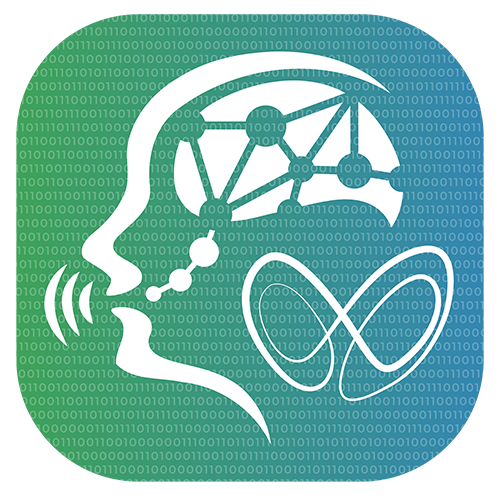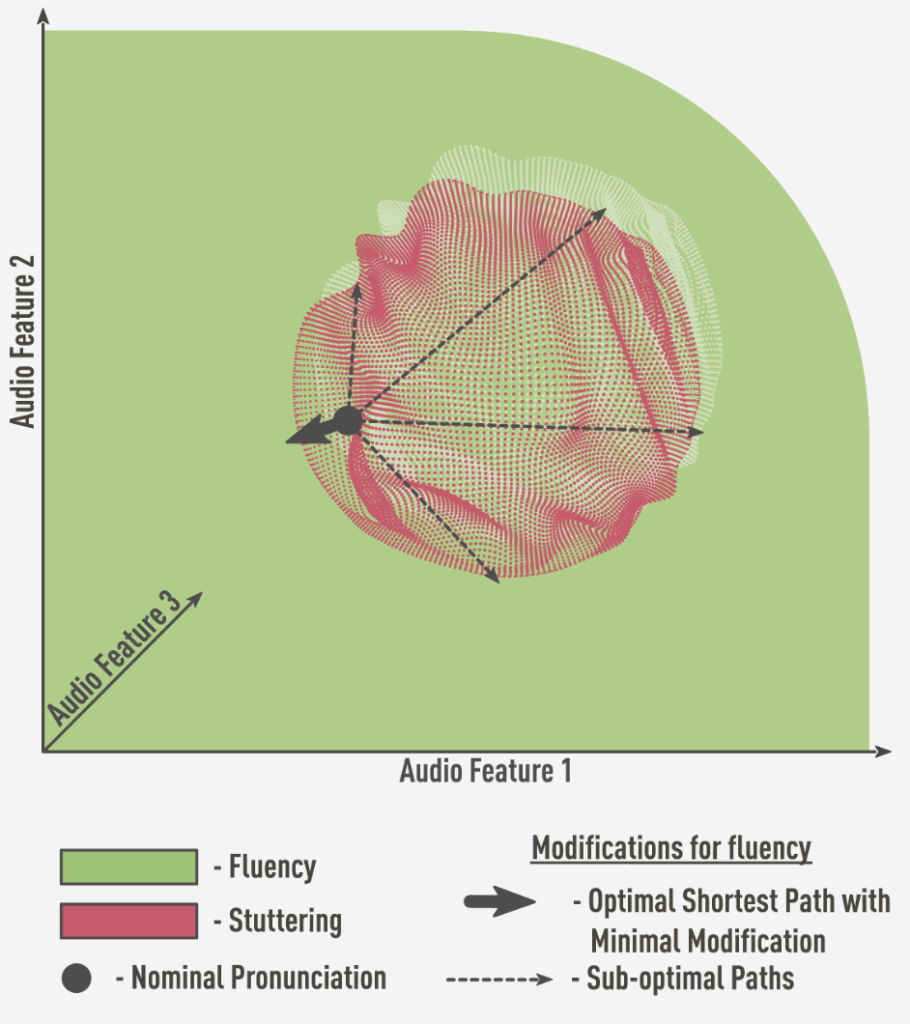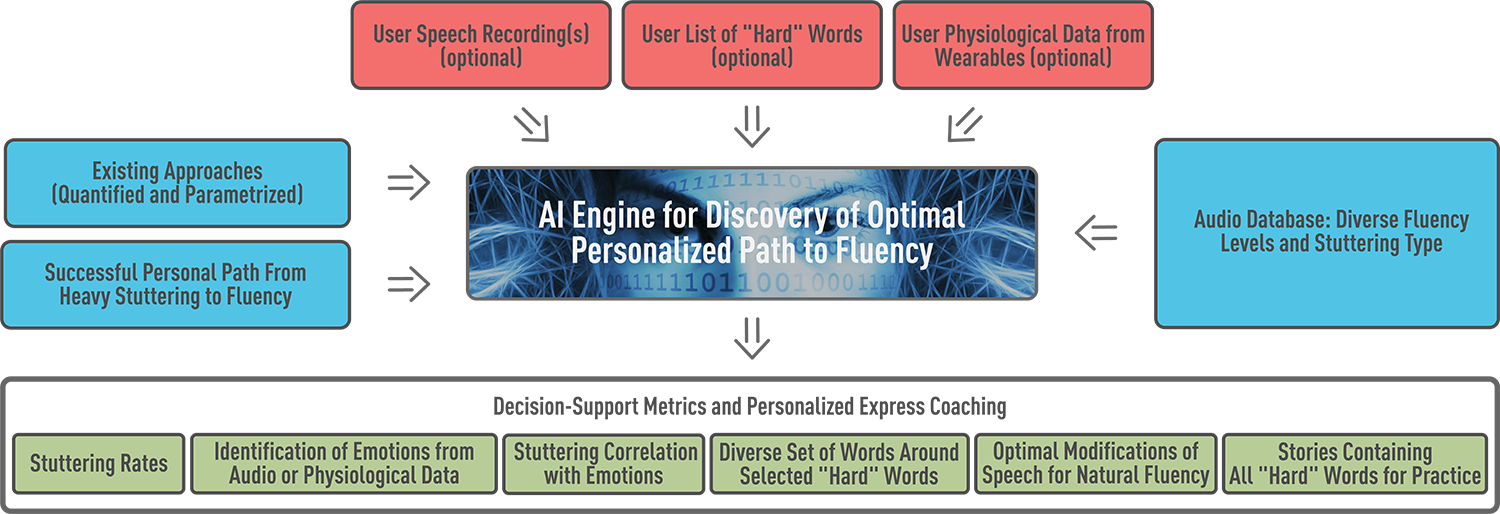Fluency Leap AI™
Analytical Platform for Multi-Expert Discovery of Personalized Biomedical Solutions

Fluency Leap AITM offers AI-driven discovery of optimal, fast and easy-to-follow personalized path to natural and persistent speech fluency for complicated stuttering cases and for mastering public speech with a desired emotional color for coach pep talks, fund raising, business meetings etc
(mobile app coming soon)
Problem
- Today, about 1% of the world’s population stutters and more than 5% of children go through a period of stuttering.
- There is no single known cause of stuttering
- There is no cure for stuttering meaning absence of reliable, research-backed “cure” that works consistently, over time, and for all people who stutter
- Dramatic impact of stuttering on quality of life ranges from daily anxiety, fear and embarrassment to long-term psychological problems and feeling of social rejection that could lead to downward correction of life goals and dreams
- Objective knowledge and empirical facts about stuttering include:
- “Developmental” stuttering, started in childhood, and “acquired” stuttering, started due to multiple physical, psychological and psychosomatic factors, are quite different in their causes, manifestations and success rate of treatment
- Researchers believe that stuttering is caused by a combination of factors, including genetics, language development, environment, as well as brain structure and function
- There are indications of the anatomical differences in the brain structure of stutterers
- EEG and fMRI studies clearly indicate differences in brain activity patterns of stutters
- fMRI studies have shown that stutters exhibit a higher right hemisphere activity when speaking
- The mechanisms associated with hearing one’s own speech may not function optimally in those who stutter
- In general, research has shown that the pathways in the brain responsible for language look and function differently when stuttering occurs
- EEG studies also confirmed existence of psycho-physiological states associated with anticipation of stuttering
- While existing knowledge could partially explain effectiveness and limitations of practical approaches for stuttering alleviation, no universal and ultimate treatment is offered yet
Current Practical Solutions
- Although there is no ultimate cure for stuttering, there are many practical techniques to alleviate stuttering and associated psychological & social problems
- Mainstream and Alternative Techniques
- Although there are continuous research efforts to discover ultimate treatment for stuttering, e.g. “Transcranial Direct Current Stimulation” (tDCS) of the brain areas, more studies are required to confirm whether they can become a real cure for stuttering
- Standalone electronic devices or apps providing real-time feedback that include “Delayed Auditory Feedback” (DAF) and “Frequency-shifted Auditory Feedback” (FAF) as well as biofeedback procedures for achieving certain speech modifications, e.g. “Modifying Phonation Intervals” (MPI) stuttering treatment
- Mainstream techniques used by Speech-Language Pathologists (SLP) include different types of speech modifications and breathing as part of “Fluency Shaping” and “Stuttering Modification” approaches: “Slowed Speech or Stretched Syllable”, “Diaphragmatic Breathing”, “Light Articulatory Contacts”, “Gentle Initiation”, “Passive Airflow Technique”, “Continuous Phonation”, “Voluntary Stuttering”, “Cancellation”, “Pulling Out” and others
- Other empirically found speech modifications techniques, e.g. acquiring a different accent, are also shared by people who stutter
- Cognitive behavioral therapy (CBT) can also be used to overcome anxiety and anticipation related to stuttering
Limitations of Existing Approaches
- Existing approaches cannot warranty fast, significant and persistent improvements in all cases
- While DAF, FAF and other real-time feedback devices / apps could effectively alleviate stuttering when used, their continuous usage is not feasible and improvements could quickly fade away
- The target of some approaches including “Stuttering Modification” techniques is not achievement of natural fluency but rather stuttering in a more controlled way with some reduction of severe episodes
- Although “Fluency Shaping” techniques demonstrated ability for a long-term impact on the auditory-to-motor pathways inside the human brain that is necessary for fluency, there is no warranty of fast speech improvements that will persist without necessity of regular sessions to maintain fluency
- Descriptions of most speech modification techniques are too explicit and complex which may prohibit direct tuning into regime of natural fluency similar to other skills like sports or playing musical instrument where final perfection is based on automatic responses without “overthinking”
- Although effectiveness of most speech modification and other techniques strongly depends on personalization, objective methods for quick and optimal personalization are often absent
- While strong speech modifications (e.g. singing) are effective but not practical, objective mechanisms for discovery of small and optimal speech modifications that maximally use hidden personal abilities for natural fluency are not available
- There is no systematic usage of audio and physiological data for optimal personalization including fast fine-tuning of explored techniques and identification of emotional states including stuttering anticipation
Our Multi-Expert Solution: Fluency Leap AI™
- The main goal of our system is AI-driven discovery of optimal, fast and easy-to-follow personalized path to natural and persistent speech fluency
- The key edge of our AI framework is quantification and combination of the best speech modification techniques and successful personal path to fluency of one of the system authors with the ability of further multi-objective optimization
- Given optional user-specific inputs such as speech recordings, personal list of “hard” words and physiological data, our algorithm will discover the personalized fluency regions for further optimization of speech modification (see diagram)
- Discovered optimal speech modifications are directly presented to the user as modified audio files for each “hard” word - no confusing and complex descriptions
- Our system also finds stuttering rates / types and emotional states from audio files which can be used
- For quick optimal selection and performance monitoring of any fluency shaping technique
- For objective measuring of stuttering anticipation levels
- For objective measuring of stuttering anticipation levels
- For discovery of best / worst emotional states for personal speech fluency and other fluency vs emotion correlations

Fluency Leap AI™: Features, Components
and Operation
- User Inputs – will work with any combination of provided inputs (all inputs are optional)
- Speech Recording(s)
- List of “Hard” Words
- Physiological Data from Smartwatches, fitness trackers and other wearables
- Knowledge and Data used by AI Engine for Transfer Knowledge, Training and Fine-Tuning
- Quantified and Parametrized Techniques for Stuttering Alleviation Currently Used by Practitioners
- Knowledge from Successful Personal Path from Heavy Stuttering to Fluency (real experience of one of the system developers)
- Audio Data Sets with Diverse Fluency Levels and Stuttering Types (Public and Proprietary Data)
- Multiple Decision-Support Metrics and Personalized Express Coaching Sessions Generated by the System
- Stuttering Rates …
- Emotional States Identified from Audio or Physiological Data
- Correlation of Stuttering Rates with Emotional States
- Diverse Set of Words Around Selected "Hard" Words (Identified by Multiple Audio Features Optimized for this Application)
- Minimal Audio Modification of each “Hard” Word for Natural Speech Fluency (Personalized Multi-Objective Optimization)

© 2019 Medpobs. Powered by VOOV.